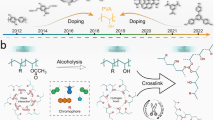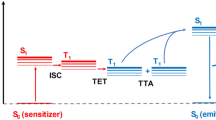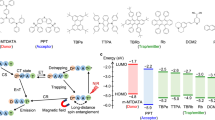Abstract
The current drive to produce cheap, flexible plastic displays1 has led to rapid improvements in device efficiency. Inclusion of highly phosphorescent heavy-metal organic complexes as dopants ensures that both singlet and triplet excitations formed on charge recombination can be used efficiently to emit light2. However, the inclusion of these dopants affects the photophysics of the host in a surprising way, generating a ten- to twenty- fold instantaneous increase in the number of host triplet states, independent of host triplet energy, quenching up to 95% of all singlet states. Once created however, these triplets are only weakly quenched by the same mechanism. We ascribe this to a resonant, remote intermolecular heavy-atom effect that greatly increases the inter-system crossing rate of the host polymer3 arising through the strong overlap of the delocalized π orbitals of the host and ligands. This mechanism competes effectively with Förster energy transfer, and operates over large distances.
This is a preview of subscription content, access via your institution
Access options
Subscribe to this journal
Receive 12 print issues and online access
$259.00 per year
only $21.58 per issue
Buy this article
- Purchase on Springer Link
- Instant access to full article PDF
Prices may be subject to local taxes which are calculated during checkout




Similar content being viewed by others
References
Friend, R. H. et al. Electroluminescence in conjugated polymers. Nature 397, 121–128 (1999).
Forrest, S. R. The path to ubiquitous and low-cost organic electronic appliances on plastic. Nature 428, 911–918 (2004).
Robinson, G. W. Intensity enhancement of forbidden electronic transitions by weak intermolecular interactions. J. Chem. Phys. 46, 572–585 (1967).
King, S., Rothe, C. & Monkman, A. Triplet build in and decay of isolated polyspirobifluorene chains in dilute solution. J. Chem. Phys. 121, 10803–10808 (2004).
Burrows, H. D. et al. S-1 similar to >T−1 intersystem crossing in pi-conjugated organic polymers. J. Chem. Phys. 115, 9601–9606 (2001).
Rothe, C., Palsson, L. O. & Monkman, A. P. Singlet and triplet energy transfer in a benzil-doped, light emitting, solid-state conjugated polymer. Chem. Phys. 285, 95–101 (2002).
O’Brien, D. F. et al. Electrophosphoresence from a doped polymer light emitting diode. Synth. Met. 116, 379–383 (2001).
van Dijken, A. et al. Carbazole compounds as host materials for triplet emitters in organic light-emitting diodes: Polymer hosts for high-efficiency light-emitting diodes. J. Am. Chem. Soc. 126, 7718–7727 (2004).
Hay, P. J. Theoretical studies of the ground and excited electronic states in cyclometalated phenylpyridine Ir(III) complexes using density functional theory. J. Phys. Chem. A 106, 1634–1641 (2002).
Brunner, K. et al. Carbazole compounds as host materials for triplet emitters in organic light-emitting diodes: Tuning the HOMO level without influencing the triplet energy in small molecules. J. Am. Chem. Soc. 126, 6035–6042 (2004).
van Dijken, A. et al. Carbazole compounds as host materials for triplet emitters in organic light-emitting diodes: polymer hosts for high-efficiency light-emitting diodes. J. Am. Chem. Soc. 126, 7718–7727 (2004).
Rothe, C., King, S. & Monkman, A. P. A systematic study of the dynamics of triplet exciton transfer between conjugated host polymers and phosphorescent iridium (III) guest emitters. Phys. Rev. B (in the press).
Petelenz, P. & Funfschilling, J. Resonantly enhanced external heavy-atom effect in organic glasses. Chem. Phys. 145, 333–342 (1990).
Basu, G., Kubasik, M., Anglos, D. & Kuki, A. Spin-forbidden excitation transfer and heavy-atom induced intersystem crossing in linear and cyclic-peptides. J. Phys. Chem. 97, 3956–3967 (1993).
Knaapila, M. et al. X-ray diffraction studies of multiple orientation in poly(9,9-bis(2-ethylhexyl)fluorene-2,7-diyl) thin films. J. Phys. Chem. B 107, 12425–12430 (2003).
Rothe, C., King, S. M., Dias, F. & Monkman, A. P. Triplet exciton state and related phenomena in the beta-phase of poly(9,9-dioctyl)fluorene. Phys. Rev. B 70, 195213 (2004).
Romanova, Z. S., Deshayes, K. & Piotrowiak, P. Remote intermolecular “heavy-atom effect”: Spin-orbit coupling across the wall of a nemicarcerand. J. Am. Chem. Soc. 123, 2444–2445 (2001).
Nicolet, O. & Vauthey, E. Heavy atom effect on the charge recombination dynamics of photogenerated geminate ion pairs. J. Phys. Chem. A 107, 5894–5902 (2003).
Osterbacka, R., Wohlgenannt, M., Chinn, D. & Vardeny, Z. V. Optical studies of triplet excitations in poly(p-phenylene vinylene). Phys. Rev. B 60, R11253–R11256 (1999).
Rothe, C. & Monkman, A. Dynamics and trap-depth distribution of triplet excited states in thin films of the light-emitting polymer poly (9,9-di(ethylhexyl)fluorene). Phys. Rev. B 65 (073201) (2002).
Monkman, A. P. et al. The effect of conjugation length on triplet energies, electron delocalization and electron-electron correlation in soluble polythiophenes. J. Chem. Phys. 115, 9046–9049 (2001).
Xu, Y. H. et al. Efficient white-light-emitting diodes based on polymer codoped with two phosphorescent dyes. Appl. Phys. Lett. 87, 193502 (2005).
Al Attar, H. A., Monkman, A. P., Tavasli, M., Bettington, S. & Bryce, M. R. White polymeric light-emitting diode based on a fluorene polymer/Ir complex blend system. Appl. Phys. Lett. 86, 121101 (2005).
Rothe, C., Guentner, R., Scherf, U. & Monkman, A. P. Trap influenced properties of the delayed luminescence in thin solid films of the conjugated polymer poly(9,9-di(ethylhexyl)fluorene). J. Chem. Phys. 115, 9557–9562 (2001).
Acknowledgements
The authors wish to thank Covion (now Merck) and B. M. W. Langevelt for supplying materials, H. Burrows for helpful discussions and CENAMPS and ONE North East for financial support.
Author information
Authors and Affiliations
Corresponding author
Ethics declarations
Competing interests
The authors declare no competing financial interests.
Supplementary information
Supplementary Information
Supplementary figures 1, 2 and 3 (PDF 64 kb)
Rights and permissions
About this article
Cite this article
Rothe, C., King, S. & Monkman, A. Long-range resonantly enhanced triplet formation in luminescent polymers doped with iridium complexes. Nature Mater 5, 463–466 (2006). https://doi.org/10.1038/nmat1630
Received:
Accepted:
Published:
Issue Date:
DOI: https://doi.org/10.1038/nmat1630
This article is cited by
-
Singlet Exciton Fraction in Electroluminescence from Conjugated Polymer
Scientific Reports (2017)
-
Phosphorescence of conjugated poly-para-phenylene polymers sensitized by an organometallic complex with a heavy metal atom
Journal of Applied Spectroscopy (2007)



